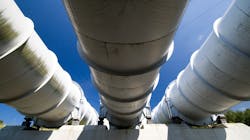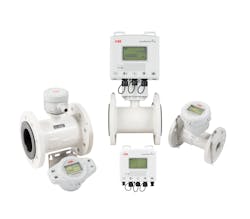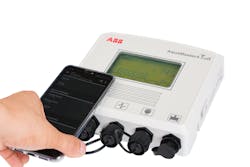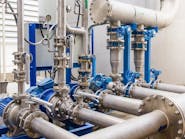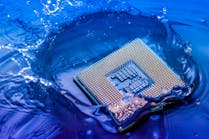Finding ways to stem losses from water distribution networks is an ongoing mission for the world’s water companies. With factors such as rising urbanization, industrialization and irrigation for agriculture all putting the world’s finite freshwater supplies under mounting pressure, water utilities are expected by governments and the public alike to be one step ahead when it comes to ensuring that every possible drop of water gets to where it is needed.
This is a tough ask, requiring a thorough understanding of what is happening in pipelines stretching thousands of miles across a range of diverse territories. While some countries have made significant inroads in tackling water losses in their networks, others have much further to go, with losses through leakage especially running into high double figures in some parts of the world.
The extent of the problem is highlighted by a 2019 study by the International Water Association which estimates that approximately 346 billion liters of treated water are lost every day from pipelines worldwide. With every drop lost also representing potential lost revenue that could be reinvested into upgrading networks, it is vital to ensure that measures are put in place not only to detect the location and extent of any losses, but also to explain why they are happening.
Improvement starts with measurement
When it comes to measuring flow to help detect lost water, two key factors need to be considered.
The first concerns the choice of technology for measuring flow. Depending on the application, different flow measurement techniques can be used, from constrictive methods such as flumes and weirs for open channel systems, to orifice, mechanical, ultrasonic or electromagnetic flowmeters in closed pipe systems. Many of these will have their own set of benefits and drawbacks that can affect their ability to measure accurately.
The second is where the measurements need to be made. By providing data on the quantity and location of water losses, measurement can help operators to develop a suitable strategy to prevent them reoccurring. To provide a full picture of what is happening in the network, any measurements therefore need to be performed as widely as possible. Given that water pipelines pass through a variety of areas any device used to measure flows must be as easy as possible to install, access and maintain.
For operators looking for consistent accuracy, high reliability and stability and suitability for a range of installation environments, electromagnetic flowmeters can provide the answer.
Compared to other flowmeter types, electromagnetic flowmeters offer greatly enhanced accuracy and repeatability throughout their operational life, with an accuracy of as low of +/- 0.4%. This accuracy is especially important when measuring for lost water. If the instruments used to gather the data are not accurate and underestimate the legitimate consumption, then in many places the overall water loss estimate may be grossly overstated.
Reliability is another important benefit of electromagnetic flowmeters. With no moving parts, they do not suffer from problems with wear and tear, minimizing maintenance and requiring no upstream strainers to filter sediment, reducing installation costs.
Furthermore, the ability of specially designed electromagnetic flowmeters to handle distorted velocity profiles without impacting on accuracy eliminates the need for lengths of pipeline upstream or downstream of the point of installation that are required by other meter types. These designs allow the ability to be fitted anywhere, making them particularly ideal for urban locations, where available space to install the meter may be limited.
The benefits of going digital
Ongoing advances in technology are helping to augment the benefits of electromagnetic flowmeters, making them an increasingly cost effective and practical means of gaining a robust understanding of what is happening in water distribution networks.
One example is the development of alternatives to conventional mains power that are enabling a fit anywhere approach to flowmeter installation. Since unveiling the world’s first battery-powered device in the early 1990s, ABB has pioneered the development of renewable energy technology in its latest generation of AquaMaster electromagnetic flowmeters, enabling them to be used in remote locations without the need for a mains supply. Coupled with the inherently low footprint of electromagnetic flowmeters, these options are opening new possibilities for delivering enhanced flow measurement in a wide variety of locations. With significantly lower power consumption than conventional mains-powered devices, they also offer the prospect of significant reductions in energy cost, further emphasising the all-around lower cost of ownership possible with electromagnetic flowmeters.
Equal progress has been made in creating the communications frameworks needed to access and retrieve flow data from devices in any location. Manufacturers, including ABB, are increasingly looking at utilizing Low Power Wide Area Network (LPWAN) band and Narrow Band Internet of Things (NB-IoT) technologies into their flowmeters to facilitate fast exchange of measurement, configuration and maintenance data at greatly reduced levels of power consumption. As these technologies mature, they will offer enhanced possibilities for water supplies to be monitored and controlled more intelligently by enabling decision making based on accurate near real-time data.
Another development is the emergence of Power over Ethernet (PoE) technologies. By enabling the same cable to be used for both power and communications, PoE offers the flexibility for flowmeters to be installed wherever needed, making it ideal for industrial water measurement and control applications. In addition, ABB 4-wire Ethernet combines classic outputs with future communication protocols. Offering a modular design allows the combination of both worlds and ensures that devices are future-proof, increasing the longevity of the flowmeters.
Furthermore, flowmeters with Ethernet connectivity increase simplicity, flexibility and reliability, while enhancing real-time visibility of data. Previously hidden data in field devices, such as measurement values on density, conductivity or concentration of the medium, can be unlocked.
At a device level, features are also being included that help to reduce the time and skills needed to commission, operate and maintain electromagnetic flowmeters. ABB’s AquaMaster4 electromagnetic flowmeter, for example, uses Near Field Communications (NFC) technology to enable users to download configuration settings and retrieve logger data simply by tapping the transmitter with a smart device such as phone or tablet loaded with ABB’s Velox app. Using the app, a variety of operational, logging and diagnostic data can be downloaded, interrogated and shared to provide precise details on flow and pressure activity over a set period.
Pressure completes the puzzle
With pressure a key culprit behind pipe bursts and water leaks, effective pressure management is central to optimum water network performance. While reducing pressure to reduce leakage can be a solution for higher pressure areas, it is not always a practical solution for lower pressure areas, which could suffer from weak or interrupted water supplies if the overall supply pressure was to be reduced. For this reason, effective pressure management needs to start with effective pressure visualization to enable the right choice to be made.
When data from hydraulic (flow + pressure) measurement in a network is carefully understood and used, it can lead to significant improvements such as energy savings and improved network performance through enhanced pressure measurement.
Combining flow and pressure measurement into one device also offers the added benefit of simplifying the gathering, sharing and analysis of data. Historically, water utilities have deployed separate flowmeters and pressure transducers around networks. While this will provide data on network flow and pressure conditions, the separate deployment of instruments represents additional inputs that need to be gathered and managed by water companies, many of which lack the information infrastructures needed to process and analyze it. By integrating the two into one device, users can download logged data and investigate flow and pressure activity for a specific period. When combined with other benefits such as the ability to download and share this data through a smart device, the possibilities for improving network performance through enhanced pressure measurement are greatly expanded.
Conclusion
The absolute basics in optimum water network management lie in achieving the highest levels of flow and pressure measurement accuracy. In this way, true consumption can be properly understood and every available drop accounted, traced and charged for.
With heavy investment needed to gear up the world’s water supplies to meet the ever-growing demands being placed on them, flowmeters need to be at the frontline in ensuring that every last dollar can be recovered to help cover the cost.
Krishna H. Prashanth has been with ABB for more than 18 years and has held multiple roles globally in strategy, business development and product management. As the global product line manager for electromagnetic flowmeters, he is responsible for driving strategy, product lifecycle and profitability of the EMF product families.
